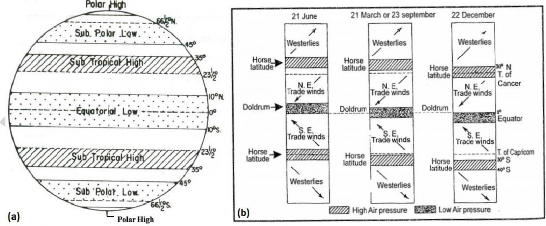4.5. Distribution of Pressure Belts
The horizontal distribution of air pressure across the latitudes is characterized by high or low pressure belts (figure 17(a)). These pressure belts are:
♤ Equatorial low pressure belt: This belt extends from equator to 100N and 100S latitudes. This belt is thermally produced due to heating by Sun.. Due to excessive heating horizontal movement of air is absent here and only vertical currents are experienced in this belt. Therefore, this belt is called doldrums (the zone of calm). . This belt is also known as-Inter Tropical Convergence Zone (ITCZ) because the trade winds flowing from sub tropical high pressure belts converge here.
♤ Sub-tropical high pressure belt: these extend roughly between 250 and 350 latitudes in both the Hemispheres. The existence of these pressure belts is due to the fact that the up rising air of the equatorial region is deflected towards poles due to the earth’s rotation. After becoming cold and heavy, it descends in these regions and get piled up. This results in high pressure. Calm conditions with feeble and variable winds are found here.. In southern hemisphere, this belt is broken by small low-pressure areas in summer over Australia and South Africa. In northern hemisphere, the belt is more discontinuous by the presence of land masses, and high pressure occurs only over the ocean areas as discrete cells; these are termed the Azores and Hawaiian cells in the Atlantic and Pacific areas respectively.
These belts are also called Horse latitudes. In older days, vessels with cargo of horses passing through these belts found difficult in sailing under these calm conditions. They used to throw the horses in the sea in order to make the vessels lighter. In the upper atmosphere over this belt the upper level westerlies and anti-trade winds converge and set up descending currents in the atmosphere.
♤ Sub-polar low pressure belt: it extends along 600 latitudes (550-650) in both the hemisphere. These belts are not thermally induced instead the winds coming from the sub- tropics and the polar regions converge in this belt and rise upward. The great temperature contrast between the subtropical and the polar regions, gives rise to cyclonic storms in this belt. In Southern hemisphere, this low pressure belt is more pronounced due to vast presence of ocean and also referred as the sub-antarctic low. But in the northern hemisphere, there are large land masses along 600 latitudes which are very cold. Therefore, the pressures over these landmasses are increased. Thus, the continuity of the belt is broken.
♤ Polar high pressure belt: Because of low temperature, air compresses and its density increases. Hence, high pressure is found here throughout the year. This is more marked over the land area of the Antarctic continent than over the ocean of the North Pole. In northern hemisphere, high pressure is not centered at the pole, but it extends from Greenland to Islands situated in the northern part of Canada.

